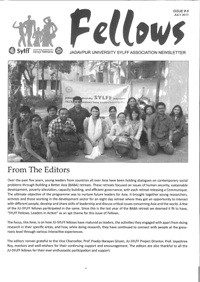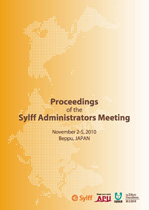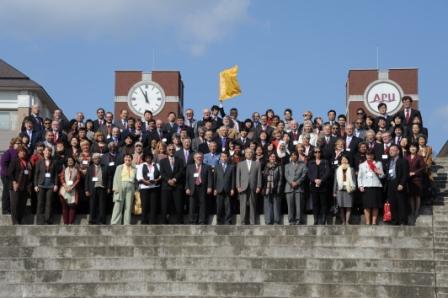University of Leipzig
November 16, 2011
November 16, 2011

November 11, 2011
From April through June 2011, students at the University of Music and Performing Arts, Vienna—one of the three music schools in the Sylff community—performed a series of concerts as a sign of solidarity with and hope for the people in Japan in the wake of the massive March 11 earthquake and tsunami and the nuclear accident.
The performers included several Sylff fellows. These concerts were a part of the students’ commitment as musicians to charitable activities. Proceeds from the event were donated to the Japan Earthquake and Tsunami Fund, managed by The Nippon Foundation, the donor of the Sylff endowment.
The Tokyo Foundation is very grateful to the students for thinking about the situation in Japan and very much appreciates their commitment and dedication to making the world a better place to live. Continue reading

November 11, 2011
 The Sylff Association at Jadavpur University has released its sixth newsletter, Fellows, featuring messages from Tokyo Foundation President Hideki Kato, Sylff Steering Committee Chairman and Jadavpur University Vice-Chancellor Pradip Narayan Ghosh, and JU-Sylff Project Director and Professor Joyashree Roy.
The Sylff Association at Jadavpur University has released its sixth newsletter, Fellows, featuring messages from Tokyo Foundation President Hideki Kato, Sylff Steering Committee Chairman and Jadavpur University Vice-Chancellor Pradip Narayan Ghosh, and JU-Sylff Project Director and Professor Joyashree Roy.
It also contains contributions from fellows, who share their ideas and insights. Two articles highlight the knowledge and experiences they gained through Sylff Research Abroad. There is a section devoted to former recipients who provide information on what they are doing now.
Click here (PDF: 2.51 MB) to read the newsletter online.
For a list of Sylff Local Associations around the world, please click here.

November 1, 2011
On September 8, 2011, Chairman Yohei Sasakawa and other officers from The Nippon Foundation—the Sylff endowment donor—visited Howard University, whose Graduate School celebrated the twentieth anniversary of its association with Sylff earlier this year.
They met with university faculty, including Graduate School Interim Dean Charles L. Betsey, Associate Provost Joseph Reidy, and Senior Academic Advisor to the President Alvin Thornton. Continue reading

May 11, 2011
By null
 From November 2 through 5, 2010, the Sylff Administrators Meeting was convened at Ritsumeikan Asia Pacific University (APU) in Beppu, Oita, on the southern island of Kyushu. APU, the newest member of the Sylff community, hosted this gathering, which was attended by some 100 administrators and faculty members representing 62 (out of 69) Sylff-endowed institutions in 40 countries, as well as 11 Sylff fellows from 8 countries.
From November 2 through 5, 2010, the Sylff Administrators Meeting was convened at Ritsumeikan Asia Pacific University (APU) in Beppu, Oita, on the southern island of Kyushu. APU, the newest member of the Sylff community, hosted this gathering, which was attended by some 100 administrators and faculty members representing 62 (out of 69) Sylff-endowed institutions in 40 countries, as well as 11 Sylff fellows from 8 countries.
The proceedings includes the minutes or summaries of all sessions in Beppu—plus photos—and the dialogue with cabinet ministers during the Tokyo field trip. The Appendix contains a List of Participants, and there is also a group photo taken in Beppu at the end of the file. Please click on the name of the session to view the file. Continue reading


February 21, 2011

November 12, 2010
By null
 From November 2 through 5, 2010, the Sylff Administrators Meeting was convened at Ritsumeikan Asia Pacific University (APU) in Beppu, on the southern island of Japan. APU, the newest member of the Sylff community, hosted this gathering, which was attended by some 100 administrators and faculty members representing 62 (out of 69) Sylff-endowed institutions in 40 countries, as well as 11 Sylff fellows from 8 countries. The Tokyo Foundation worked closely with APU on the contents of the meeting as well as the logistic and other administrative matters. Continue reading
From November 2 through 5, 2010, the Sylff Administrators Meeting was convened at Ritsumeikan Asia Pacific University (APU) in Beppu, on the southern island of Japan. APU, the newest member of the Sylff community, hosted this gathering, which was attended by some 100 administrators and faculty members representing 62 (out of 69) Sylff-endowed institutions in 40 countries, as well as 11 Sylff fellows from 8 countries. The Tokyo Foundation worked closely with APU on the contents of the meeting as well as the logistic and other administrative matters. Continue reading



July 15, 2010
By 19658
On November 22, 2006, SYLFF at ADMU (Association of SYLFF Fellows at the Ateneo de Manila University) fellows sponsored an art competition at the Pinyahan Elementary School in Quezon City. Forty public school students from grades 4 to 6 participated in the competition with the theme of ‘Paskong Pinoy’ (A Filipino Christmas).
What makes the Filipino style of Christmas so special? We have a notoriously long celebration beginning in September (the only logic being that September is the first of the months that end in ‘ber’!), when radio stations already start to play Christmas songs, the shops put their Christmas decorations up, and the Christmas countdown begins! But surely, there must be more to the Filipino Christmas than just this prolonged excitement. With anthropological curiosity, we at SYLFF at ADMU set out to capture the spirit of the Filipino Christmas as children see it, through art.
We wanted to hold an on-the-spot art competition for public school children on the theme of “Paskong Pinoy” (A Filipino Christmas). The state of public school education in the Philippines is poor – education is allotted an exceedingly small portion of the national budget. The result is a lack of classrooms, chairs and tables (with some schools holding classes on staircases and outside under mango trees), the classrooms that are available are often in rundown condition, and the salaries of the overworked teachers are inadequate. To maximize the resources a school has, they usually group classes together to accommodate more students; with the morning set of students starting classes as early as 5:45 a.m. and the second set of students starting from 12 noon.
Many of our society’s underprivileged children study in such public schools and we wanted to give them a unique opportunity to let their talents shine. And so, on a bright Wednesday morning (November 22nd, 2006), members of SYLFF at ADMU visited Pinyahan Elementary School with art materials. The choice of public school for this activity was not accidental. SYLFF at ADMU’s Karen Lacson is a proud graduate of Pinyahan. Going back to the school where she spent her happy elementary years lent a richer meaning to the phrase “giving back.” We witnessed an emotional reunion between Karen and her former teachers, who were excited to see her again after many years. It was also an inspiring moment for the students of Pinyahan to see a very successful alumna.
For the next two hours, forty of Pinyahan’s students from grades 4 to 6 diligently worked on their masterpieces. We were amazed with their work. These students are indeed very talented. SYLFF at ADMU’s members had a difficult time judging and deciding the winners. Several themes emerged from their drawings. The Filipino Christmas is about reunion with family and friends and so most of the drawings featured gatherings of people. Singing and going to church are also at the heart of the celebration. GJ Ouano, also a SYLFF fellow, shared how she was moved by one particular drawing that featured people gathered around two pieces of fish. We usually have rich foods during Christmas but for these children; having a simple meal does not diminish the joy and the color of the season.
I was struck by another drawing which featured a large orange house. Inside the house is a lone woman standing between a Christmas tree and a table laden with food. The solitude reaches out to you from the drawing and tugs at your heart. The work was entitled “Pasko Na, Sana’y Kapiling Ka” (It’s Christmastime, Wishing we’re Together). This work captured the harsh reality of labor migration in the Philippines. Many Filipino families are separated as one or both parents go abroad to earn a living. The pain of separation cannot be assuaged by the size of the house or the amount of food on the table. I was amazed by the perceptiveness of these young students.
On December 4th, 2006, we had a simple award ceremony, where we gave cash prizes to the winners. It was a one-of-a-kind early Christmas celebration for SYLFF at ADMU fellows and for the students of Pinyahan. The art works offered a visual impression of the Filipino spirit of Christmas – a true feast for the eyes!


April 15, 2010
December 15, 2008